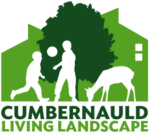It’s all in the ‘V’
,
By Katie Brown, Cumbernauld Living Landscape Trainee

Pink footed goose, c. 2020 Vision
It’s getting to that time of year where the sudden honking of geese might make you look up to the sky, searching for that so familiar ‘V’ formation. Every winter thousands of swans and geese arrive in Scotland from the tundra regions of Iceland, Greenland and Siberia, then every spring they fly north again, returning to their breeding grounds. Among the spring departures include pink footed geese, barnacle geese and whooper swans, which you can tell from our resident mute swans by their yellow bills, and their eponymous whooping calls in flight.
It makes sense to migrate as a flock because there’s safety in numbers, but why fly in the shape of a V? Well, it seems our feathered friends have found a way to work smarter not harder. The V shape helps the flock save energy during flight. The lead bird breaks up the wall of air that the flock is flying into, creating vortices of swirling air that give a lift to the next bird along. Each bird in the V gets some help from the one in front of it, and after a while the leader drops back and another bird takes over. There are even some studies that suggest birds might even be able to sleep while flying.
According to the RSPB, scientists have shown that birds flying in a V formation can fly 70 per cent further than one bird flying alone. In fact, this formation is so successful that humans are copying it. In bike races it is not uncommon to see cyclists draughting behind the leader, and some airlines are now considering the possibility of flying commercial flights in the iconic V formation as way of saving fuel and reducing pollution. We can learn a lot from birds about teamwork and efficiency.
